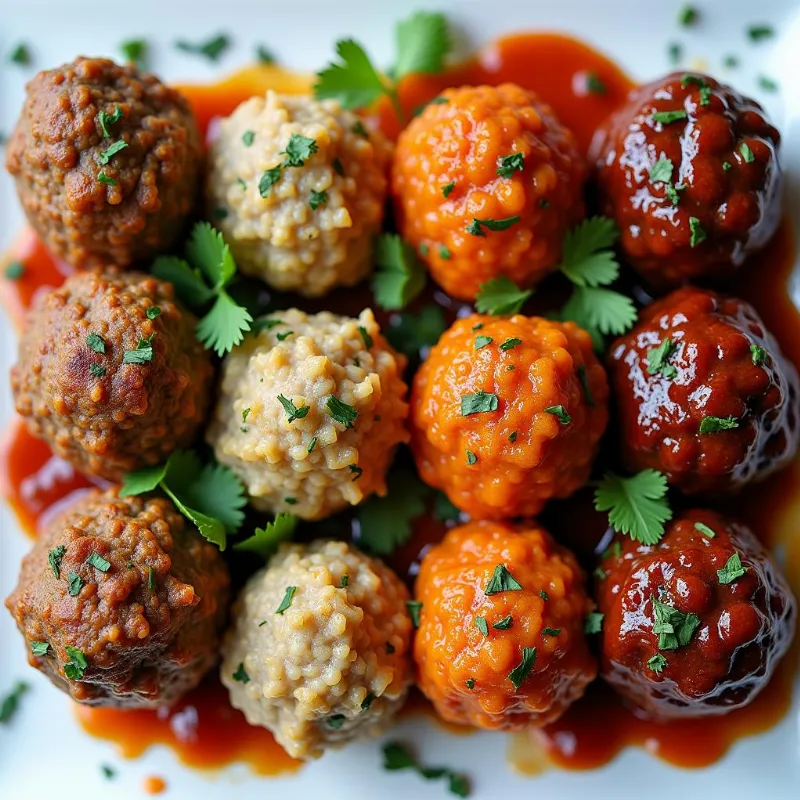Vegan meatballs? Absolutely! These plant-based wonders are here to satisfy your cravings while aligning with your vegan lifestyle. Whether you’re a seasoned vegan or simply curious about plant-based cooking, this comprehensive guide will equip you with all the knowledge and techniques to create mouthwatering vegan meatballs that are as versatile as they are delicious.
Unveiling the Versatility of Vegan Meatballs
Vegan meatballs are a testament to the creativity and diversity of plant-based cuisine. Unlike their traditional counterparts, vegan meatballs are crafted from a medley of wholesome ingredients, resulting in a dish that’s not only kind to animals but also bursting with flavor and nutrients.
One of the most enticing aspects of vegan meatballs is their remarkable versatility. They can be enjoyed in countless ways – nestled in a comforting bowl of spaghetti, simmered in a rich tomato sauce, or served as appetizers with a zesty dipping sauce. The possibilities are truly endless!
Essential Ingredients for Flavorful Vegan Meatballs
Before we embark on our culinary journey, let’s gather the key components that form the foundation of delectable vegan meatballs:
- Base Ingredients: The heart of your vegan meatballs lies in choosing a base that provides texture and substance. Popular options include lentils, beans (such as black beans or chickpeas), mushrooms, quinoa, or a combination of these ingredients.
- Binding Agents: To hold everything together, you’ll need a binding agent that adds moisture and prevents the meatballs from crumbling. Flaxseed meal, chia seeds, mashed potatoes, or breadcrumbs are excellent choices.
- Flavor Enhancers: This is where your culinary creativity shines! Experiment with aromatic vegetables like onions, garlic, and bell peppers. Herbs like oregano, basil, and thyme infuse depth, while spices like smoked paprika, cumin, and chili powder add warmth and complexity.
- Umami Boost: To replicate the savory depth of traditional meatballs, incorporate ingredients that impart umami, a fifth taste sensation often described as savory or meaty. Nutritional yeast, soy sauce, tamari, or vegan Worcestershire sauce are fantastic additions.
A Step-by-Step Guide to Crafting Perfect Vegan Meatballs
Now, let’s don our aprons and embark on the exciting journey of crafting perfect vegan meatballs:
- Prepare Your Ingredients: Begin by finely chopping your aromatic vegetables and herbs. If using dried beans or lentils, ensure they are cooked and well-drained.
- Combine the Base: In a large bowl, combine your chosen base ingredients. For a hearty texture, opt for lentils or beans. If you prefer a meatier bite, mushrooms are an excellent choice.
- Add Binding Agents: Incorporate your binding agents, ensuring they are evenly distributed throughout the mixture. This step is crucial for achieving meatballs that hold their shape.
- Infuse with Flavor: Now comes the fun part! Add your chopped vegetables, herbs, spices, and umami enhancers. Don’t be afraid to experiment and adjust the flavors to your liking.
- Mix and Shape: Using clean hands, gently combine all the ingredients until well incorporated. Avoid overmixing, as this can result in dense meatballs. Shape the mixture into meatballs of your desired size.
- Cooking Methods: You have several options for cooking your vegan meatballs:
- Baking: Preheat your oven to 375°F (190°C) and bake the meatballs for 20-25 minutes, or until golden brown and cooked through.
- Pan-Frying: Heat a drizzle of oil in a pan over medium heat and cook the meatballs for 5-7 minutes per side, or until browned and heated through.
- Air-Frying: Arrange the meatballs in a single layer in your air fryer basket and cook at 375°F (190°C) for 10-12 minutes, shaking the basket halfway through.
- Serve and Enjoy: Once cooked, your vegan meatballs are ready to be devoured! Serve them with your favorite pasta dish, nestled in a sub roll, or as a flavorful addition to salads.
 Vegan meatballs cooking in a pan
Vegan meatballs cooking in a pan
Tips for Vegan Meatball Mastery
- For extra crispy meatballs, try coating them in breadcrumbs or panko crumbs before cooking.
- To prevent sticking, lightly grease your baking sheet or pan with oil or cooking spray.
- Leftover vegan meatballs can be stored in an airtight container in the refrigerator for up to 3 days. Reheat them gently before serving.
Exploring Flavor Variations
The beauty of vegan meatballs lies in their adaptability. Let your culinary imagination run wild and explore these tantalizing flavor variations:
- Italian-Inspired: Incorporate Italian herbs like oregano, basil, and parsley, along with sun-dried tomatoes and a touch of red pepper flakes for a kick. Pair them with vegan spaghetti sauce recipe for a classic Italian feast.
- Swedish Delight: Embrace the flavors of Scandinavia by adding warming spices like allspice and nutmeg. Serve them with a creamy vegan swedish meatball sauce for an unforgettable culinary experience.
- Asian Fusion: Infuse your meatballs with Asian-inspired flavors by incorporating ginger, garlic, soy sauce, and a hint of sesame oil. Serve them with stir-fried vegetables and rice for a satisfying meal.
- BBQ Extravaganza: For a smoky and tangy twist, toss your cooked vegan meatballs in your favorite barbecue sauce and serve them as sliders, in wraps, or as a topping for nachos.
 Different types of vegan meatballs
Different types of vegan meatballs
Frequently Asked Questions About Vegan Meatballs
Can I freeze vegan meatballs?
Absolutely! Once cooked, allow the meatballs to cool completely. Place them in a single layer on a baking sheet lined with parchment paper and freeze until solid. Transfer the frozen meatballs to a freezer-safe bag or container for up to 3 months. When ready to use, thaw overnight in the refrigerator and reheat as desired.
What can I use as a substitute for breadcrumbs?
If you’re out of breadcrumbs or prefer a gluten-free option, try using rolled oats, almond flour, or crushed crackers.
Can I make vegan meatballs without a food processor?
While a food processor can make the mixing process easier, it’s not strictly necessary. You can achieve a similar texture by mashing the ingredients together by hand or using a potato masher.
How do I prevent my vegan meatballs from being too dry?
Moisture is key to preventing dry meatballs. Ensure your base ingredients are well-cooked and moist. Adding a flaxseed “egg” (1 tablespoon flaxseed meal mixed with 3 tablespoons water) can also help bind the mixture and add moisture.
Can I adjust the spices and seasonings to my liking?
Absolutely! Feel free to experiment with different herbs, spices, and seasonings to create a flavor profile that suits your taste buds.
A Final Word on Vegan Meatballs
Crafting delicious and satisfying vegan meatballs is easier than you might think. By embracing the versatility of plant-based ingredients and following these simple guidelines, you can create culinary masterpieces that are as kind to animals as they are pleasing to your palate. So gather your ingredients, put on your chef’s hat, and embark on a flavorful adventure with these delightful vegan meatballs!
